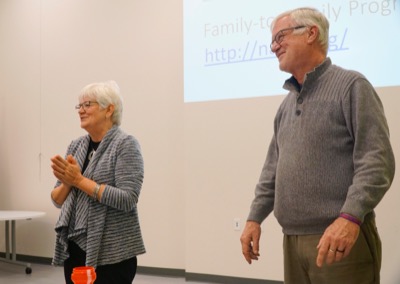Monday, December 3rd, 2018
Youth warned of vaping dangers
Officials say more education needed
By Sydney Albert

Photo by Dan Melograna/The Daily Standard
Educators and health officials are concerned that underage children are taking up vaping, thinking it is a safer alternative to smoking.
CELINA - Vaping's popularity among America's youth has recently prompted new regulations, but at least part of the problem may be a lack of education for kids and parents alike.
A study from the U.S. Centers for Disease Control and Prevention published in June reported about one in five high school students and one in 18 middle school students was using a tobacco product in 2017. Since 2014, e-cigarettes, a nicotine delivery system in which the user inhales water vapor instead of smoke, have been the most commonly used tobacco product among both middle and high school students, the report read. E-cigarettes are grouped as a tobacco product because of their nicotine content even though they do not contain any tobacco.
Amy Miller, chair of the Mercer County Prevention Coalition and a prevention specialist with Foundations Behavioral Health Services, has visited several local schools to talk with staff and students about vaping.
"After speaking with the principals and the guidance counselors and students and everything, we realized vaping is huge in our schools right now," Miller said.
Kids often believe the liquid in vaping products contains only water and flavoring and think the product is less dangerous than typical cigarettes because they don't contain tobacco. Parents she's spoken to have also had the impression that e-cigarettes are mostly harmless.
Miller said they often don't realize the addictive substance nicotine is still present in vaping products, and even in trace amounts of the "nicotine-free" products. Companies can say their products are "nicotine free" by reducing the amount to be just less than what is required for reporting by the Food and Drug Administration, not by eliminating it entirely.
"Using nicotine, regardless of how it is delivered, increases the risk of addiction. Nicotine is one of the top drugs that is hardest to quit," she said.
Each pod produced by Juul Labs, a vaping brand, contains enough liquid for about 200 puffs and as much nicotine as an entire pack of cigarettes. Miller said because the delivery system is small, resembling a USB drive, and produces less noticeable vapor, kids have been able to vape in class, bathrooms and hallways in schools. E-cigarettes also have been used to vape liquid THC, the effective part of marijuana, and other products, Miller said.
Nicotine aside, Miller said e-cigarettes have other potential risk factors. The American Lung Association has come out against vaping flavors that use the chemical diacetyl, which has been linked to a serious type of lung disease commonly referred to as "popcorn lung." E-cigarette industry advocates have said while breathing the chemical in powder form can cause problems, the risks of vaping e-liquids containing diacetyl remain uncertain.
Earlier this month, Food and Drug Administration Commissioner Scott Gottlieb announced new regulations "aimed at addressing the disturbing trend of youth nicotine use," particularly going after the flavored products that are especially popular with young Americans.
The changes would require all flavored e-liquids other than tobacco, mint and menthol be sold in age-restricted, in-person locations and, if sold online, under heightened practices for age verification.
However, vaping products were already age-restricted, and while Miller has heard rumors of some establishments where underage children could buy vaping products, they have other ways to gain access. Older siblings and older high schoolers will buy the products themselves and sell it to younger siblings or students, she noted.
Miller recently told the newspaper she's glad the FDA is stepping in and hopes the regulations help, but parents and kids still need to be educated and know how addicting the products can be.
"Kids know about this. You have to be educated, and if you aren't educated, they're going to educate you by doing it behind your back," she said.
Local schools have tobacco-free policies in place that include bans on e-cigarettes and vaping, but several have still had to discipline students or heard reports of vaping on school grounds. Celina City Schools Superintendent Ken Schmiesing said he knows of some students who were disciplined this year for violating the policy.
"I think they do have that false myth that vaping is much safer than smoking when in fact it really is not," Schmiesing said. "So I think that's probably the bigger issue. Seems like it is gaining much popularity among the high school students and college students."
Schmiesing brought up the fines the tobacco industry once faced for false advertising and wondered if the vaping industry would soon see something similar. The industry has been accused of advertising to children by numerous sources, and the FDA has partnered with the Federal Trade Commission to target e-liquid manufacturers whose products use kid-appealing imagery that mimicked juice boxes, lollipops and other foods.
"But how long will it be before we truly understand all the bad health issues that result from vaping that we don't know at this time? If we have all those people with breathing problems from popcorn lung and all that ends up developing, what kind of a cost is that going to be against our society to care for all those people?" Schmiesing asked.



